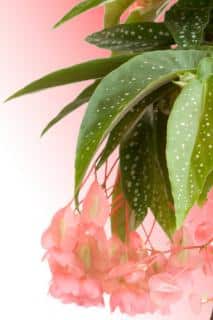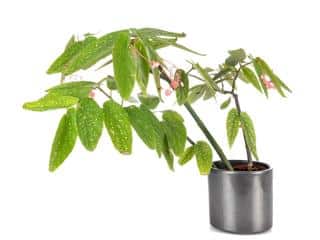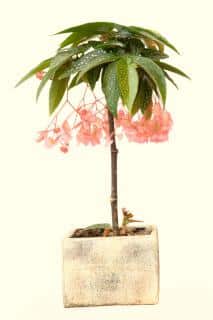

Tamaya, also called bamboo begonia, is an elegant indoor begonia with many blooms.
Begonia maculata ‘tamaya’ facts
Name – Begonia maculata
Synonym – B. albopicta ‘Tamaya’
Family – Begoniaceae
Type – perennial down to 50°F (10°C)
Flowering – end spring → early fall
Height: 8-16 in (20-40 cm) – Exposure: full/part sun – Soil: rich, well drained
Easy and quite resilient, this begonia is a very ornamental plant.
This begonia loves rich soil that drains well.

Tamaya begonia can only survive outdoors in tropical or subtropical climates because it is vulnerable to the cold in winter. It must have temperatures of at least 60°F (15°C) all year round.
However, you can bring your Tamaya out to your terrace or balcony as soon as temperatures rise above 65°F (18°C) both in the night and in the day.
Tamaya is propagated through cuttings. This step is usually performed at the heart of winter when the blooming is at its lowest.
But the season to make cuttings can shift depending on the growing conditions. The basic rule is to wait for the plant to have drifted into its dormant phase.
 Snip off a branch that has not born flowers just after a bud.
Snip off a branch that has not born flowers just after a bud.
Tamaya must be watered when the surface of the soil is dry.
Almost any type of fertilizer will do, as long as it is balanced. This means it should contain equal amounts of nitrogen, potassium and phosphorus (the N, K and P symbols).
If anything, reduce doses written on the packaging by half. You can reduce the dose by increasing dilution. For example, if the package says to pour one cap-full in a quart (liter) of water, then pour it in a half-gallon (two liters) instead.
Only increase to normal doses if you don’t see any betterment after three full months.
Prepare your own natural begonia fertilizer from comfrey or from stinging nettle:
This very beautiful plant native to Central and South America (Mexico) branched into very many species with unique colors and shapes.
This is a plant that is both robust and easy-going and it belongs to the same family as begonia.
Tamaya blooms several times a year and each time it does so, delicate pale pink to carmine red flowers are born depending on the variety and the growing environment.
You’ll also notice its evergreen leafage that evolves from bright green to emerald green. It is sprinkled with silver spots delicately ordered along leaf veins. It truly shines as an exquisite ornamental plant. The scientific name maculata comes from these spots. On the other hand, the second name of this begonia, “bamboo begonia“, comes from the shape of its stem.
The variety that is specifically called ‘Tamaya ®’ is actually a patented cultivar. In an nutshell, it means that it was developed by breeders who patiently ensured it would constantly provide us with its beauty! Propagating it for sale is thus currently prohibited.
Tamaya can survive for decades, but it tends to grow sparse and blooms decrease in time.
To avoid this, you must prune on a regular basis and enrich the soil with fertilizer.
Why is begonia Tamaya so hard to find, or you can’t find it in the United States?
Hi Brandon, it’s mostly sold in Europe, but online some retailers will ship to the US. And if you know someone who has one, it’s very easy to propagate from cuttings!
Which fertilizer do you recommend for these Tamaya? And also, how do you prune them?
Hi Terry! You can use any flower fertilizer, or even easily make your own from weeds that can be fermented. It’s important not to fertilize too much.
As for pruning, spring is the best season. Simply cut back stems by about half (leaving the tall trunk intact) and then maintain it during the growing season by pinching (snipping) off young stems after a couple or three buds.
Thank you so much for your post and answers to my questions.
Terry